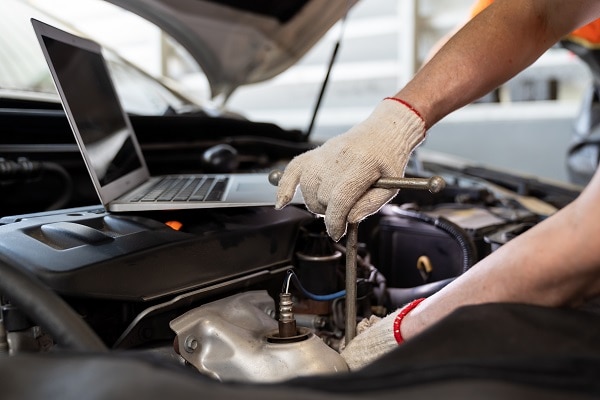Check Engine Light On? Central Vermont Auto Mart Can Help
🚨 What to Do When Your Check Engine Light Comes On
So, you're driving along, enjoying the tunes, when suddenly, the check engine light pops up on your dashboard. Cue the panic, right? Well, don't hit the panic button just yet! Let's break down what this warning light is all about.
Think of the check engine light as your car's way of waving a red flag. It's like your car's personal alarm system, letting you know that something isn't quite right under the hood. It could be anything from a loose gas cap to a more serious engine issue. When your car's internal computer identifies a problem with the engine or transmission, it turns on the check engine light.
If the check engine light is flashing, it should be more than a nudge, a flashing light indicates a serious concern with the monitored components in your vehicle's powertrain. You've got to figure out what's going on under the hood.
The check engine light doesn't give you the full story of what is happening. It's more like a hint, a nudge to say, "Hey, pay attention!" That's where the real detective work begins.
🚗 Common Causes for the Check Engine Light
- Leaking emission system components including a loose or faulty gas cap
- Oxygen sensor failure
- Catalytic converter issues
- Mass airflow sensor malfunction
- Spark plug or ignition coil problems
Ignoring the check engine light can lead to decreased fuel efficiency and potential long-term damage.
🔍 Importance of Prompt Diagnostics
Addressing the check engine light promptly ensures your vehicle remains safe and efficient. Delaying diagnostics can actually be expensive. That malfunctioning sensor might be under $100, but if it isn't addressed and contributes to a catalytic convertor failing, do you really want to spend $1500 or more on a repair that could have been prevented?
Once you notice your check engine light is on, pay attention to how the car is driving. Does something feel off? If so, get a trained mechanic to check your car out. If the car seems to be running fine, you can check a few things on your own before heading to the mechanic.
If you have recently got gas and your vehicle is equipped with a gas cap, check and ensure it is tight. A loose cap may be the problem. Tighten the cap and drive it for a few days to see if the light will go out, again keeping in mind that a flashing light would not include a loose gas cap and should get immediate attention.
If you are mechanically inclined, you might get a code reader or have a local auto parts store see what kind of diagnostic trouble code (DTC) has been set by your vehicle's internal computer. This will identify the problem, but not always how to fix it. There are over 1400 reasons a check engine light might illuminate on some models.
🛠️ Can't You Just Read a Code and Replace a Part
Here is an example of another common check engine light issue and why the code will let you know the problem, but you need to go a little further to correctly diagnose the problem. Let's say you are driving a 2021 Jeep Compass, and your check engine light comes on. You have a friend that has a code reader, they check and tell you have code P0138 set for a bad 02 sensor. This code indicates the problem. It doesn't tell you that the definitive fix is replacing the 02 sensor. You could and it might fix the problem, but it also might not fix the problem and cause you to waste money tossing parts at the problem.
Your vehicle's internal computer monitors this system continuously when the car is running. Provided your battery voltage is between 11.0 and 15.75 volts, the fuel delivery mode is set to run, and the closed loop downstream fuel system has been enabled for more than one second, the light will set if it detects the voltage reading from the O2 sensor is greater than 1.196 volts longer than 8.96 seconds. If this happens your check engine light will illuminate, and a DTC will set for code P0138.
The shop manual shows nine (9) possible reasons for this code and yes one of the reasons is to replace the O2 sensor, but this is not the only fix. Now you start to understand why repairing the vehicle right the first time and possibly at the lowest cost is to have a trained mechanic perform the diagnostic work and repair.

💡 Importance of Prompt Diagnostics
Seeing the dreaded check engine light on your vehicle's dashboard, don't ignore it. Addressing the check engine light promptly ensures your vehicle remains safe and efficient.
Driving with unresolved engine codes can lead to reduced fuel efficiency, costly engine or transmission damage and will keep your vehicle from passing a Vermont state safety inspection.
🔧 Expert Check Engine Light Repairs in Montpelier and Barre, VT
At Central Vermont Auto Mart, we specialize in diagnosing and repairing check engine light issues for drivers in Montpelier, Barre, and the surrounding area. Our experienced technicians use state-of-the-art equipment to identify and resolve problems efficiently. Whether you're in Montpelier or Barre, trust us for reliable check engine light repairs. Visit our service center located at 365 River Street, across from Tractor Supply in Montpelier to ensure your vehicle is running smoothly.
Don't let a check engine light disrupt your day. Contact Central Vermont Auto Mart to schedule a diagnostic appointment. Our team is here to provide top-notch service and get you back on the road safely.
Published Winter 2023-2024, Updated April 23, 2025


